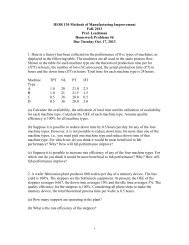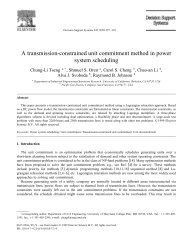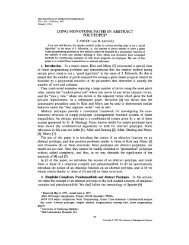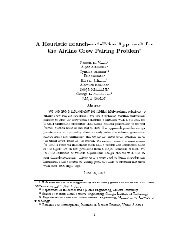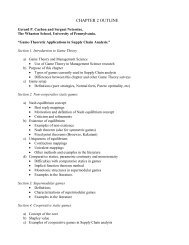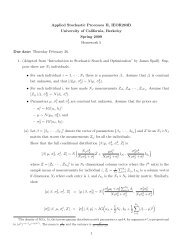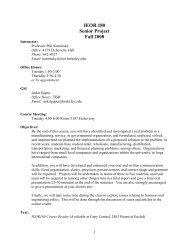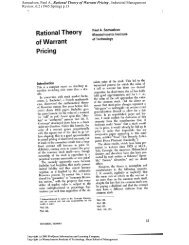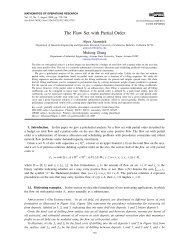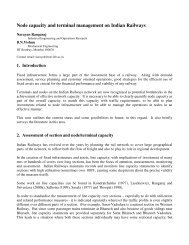IEOR 269, Spring 2010 Integer Programming and Combinatorial ...
IEOR 269, Spring 2010 Integer Programming and Combinatorial ...
IEOR 269, Spring 2010 Integer Programming and Combinatorial ...
You also want an ePaper? Increase the reach of your titles
YUMPU automatically turns print PDFs into web optimized ePapers that Google loves.
<strong>IEOR</strong><strong>269</strong> notes, Prof. Hochbaum, <strong>2010</strong> 5<br />
3.2 Piecewise linear cost function<br />
Consider the following problem:<br />
n∑<br />
min f i (x i )<br />
i=1<br />
where n ∈ N, <strong>and</strong> for i ∈ {1, . . . , n}, f i is a piecewise linear function on k i successive intervals.<br />
Interval j for function f i has length w j i , <strong>and</strong> f i has slope c j i<br />
on this interval, (i, j) ∈ {1, . . . , n} ×<br />
{1, . . . , k i }. For i ∈ {1, . . . , n}, the intervals for function f i are successive in the sense that the<br />
supremum of interval j for function f i is the infimum of interval j +1 for function f i , j ∈ {1, . . . , k i −<br />
1}. The infimum of interval 1 is 0, <strong>and</strong> the value of f i at 0 is fi 0 , for i ∈ {1, . . . , n}. The notations<br />
are outlined in Figure 2.<br />
f i (x i )<br />
✻<br />
f 0 i<br />
c ✁ ✁❅ 1 ❅<br />
c 2 i<br />
i<br />
✁ ❅<br />
✁ ✁ ❅✏ ✏✏ c 3 i ❍ ❍<br />
✁<br />
❇<br />
c<br />
❇<br />
k i<br />
i<br />
❇ <br />
❇<br />
w 1 i w 2 i w 3 i w k i<br />
i<br />
✲ x i<br />
Figure 2: Piecewise linear objective function<br />
We define the variable δ j i , (i, j) ∈ {1, . . . , n} × {1, . . . , k i}, to be the length of interval j at which f i<br />
is estimated. We have x i = ∑ k i<br />
j=1 δj i .<br />
The objective function of this problem can be rewritten ∑ (<br />
n<br />
i=1<br />
fi 0 + ∑ )<br />
k i<br />
j=1 δj i cj i<br />
. To guarantee<br />
that the set of δ j i<br />
define an interval, we introduce the binary variable:<br />
{<br />
y j i = 1 if δ j i > 0<br />
0 otherwise<br />
<strong>and</strong> we formulate the problem as:<br />
⎛<br />
n∑ ∑k i<br />
min ⎝f i 0 +<br />
i=1<br />
j=1<br />
δ j i cj i<br />
⎞<br />
⎠<br />
subject to w j i yj+1 i<br />
≤ δ j i ≤ wj i yj i<br />
for (i, j) ∈ {1, . . . , n} × {1, . . . , k i } (5)<br />
y j i ∈ {0, 1}, for (i, j) ∈ {1, . . . , n} × {1, . . . , k i}




